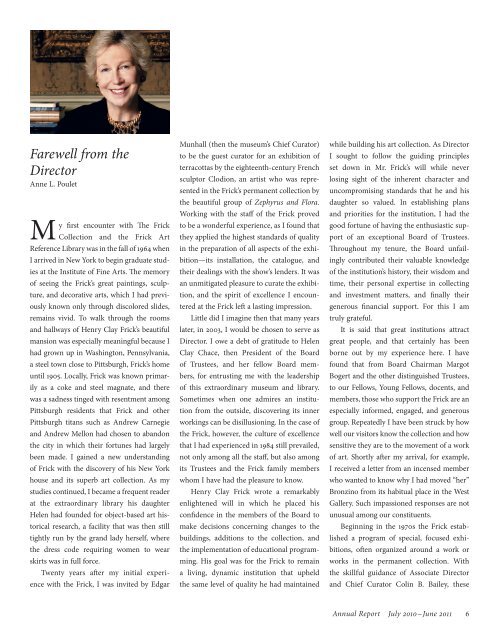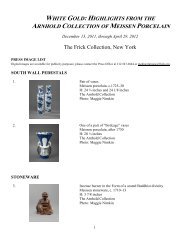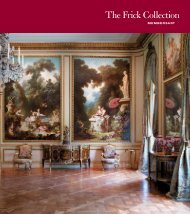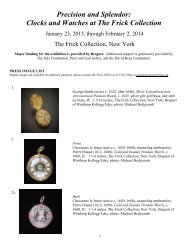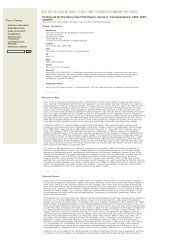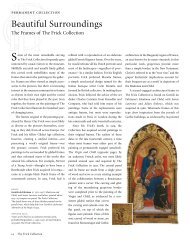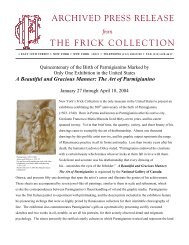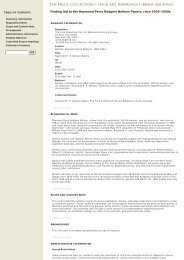Annual Report - The Frick Collection
Annual Report - The Frick Collection
Annual Report - The Frick Collection
Create successful ePaper yourself
Turn your PDF publications into a flip-book with our unique Google optimized e-Paper software.
Farewell from the<br />
Director<br />
Anne L. Poulet<br />
My first encounter with <strong>The</strong> <strong>Frick</strong><br />
<strong>Collection</strong> and the <strong>Frick</strong> Art<br />
Reference Library was in the fall of 1964 when<br />
I arrived in New York to begin graduate stud-<br />
ies at the Institute of Fine Arts. <strong>The</strong> memory<br />
of seeing the <strong>Frick</strong>’s great paintings, sculp-<br />
ture, and decorative arts, which I had previ-<br />
ously known only through discolored slides,<br />
remains vivid. To walk through the rooms<br />
and hallways of Henry Clay <strong>Frick</strong>’s beautiful<br />
mansion was especially meaningful because I<br />
had grown up in Washington, Pennsylvania,<br />
a steel town close to Pittsburgh, <strong>Frick</strong>’s home<br />
until 1905. Locally, <strong>Frick</strong> was known primar-<br />
ily as a coke and steel magnate, and there<br />
was a sadness tinged with resentment among<br />
Pittsburgh residents that <strong>Frick</strong> and other<br />
Pittsburgh titans such as Andrew Carnegie<br />
and Andrew Mellon had chosen to abandon<br />
the city in which their fortunes had largely<br />
been made. I gained a new understanding<br />
of <strong>Frick</strong> with the discovery of his New York<br />
house and its superb art collection. As my<br />
studies continued, I became a frequent reader<br />
at the extraordinary library his daughter<br />
Helen had founded for object-based art his-<br />
torical research, a facility that was then still<br />
tightly run by the grand lady herself, where<br />
the dress code requiring women to wear<br />
skirts was in full force.<br />
Twenty years after my initial experi-<br />
ence with the <strong>Frick</strong>, I was invited by Edgar<br />
Munhall (then the museum’s Chief Curator)<br />
to be the guest curator for an exhibition of<br />
terracottas by the eighteenth-century French<br />
sculptor Clodion, an artist who was repre-<br />
sented in the <strong>Frick</strong>’s permanent collection by<br />
the beautiful group of Zephyrus and Flora.<br />
Working with the staff of the <strong>Frick</strong> proved<br />
to be a wonderful experience, as I found that<br />
they applied the highest standards of quality<br />
in the preparation of all aspects of the exhi-<br />
bition—its installation, the catalogue, and<br />
their dealings with the show’s lenders. It was<br />
an unmitigated pleasure to curate the exhibi-<br />
tion, and the spirit of excellence I encoun-<br />
tered at the <strong>Frick</strong> left a lasting impression.<br />
Little did I imagine then that many years<br />
later, in 2003, I would be chosen to serve as<br />
Director. I owe a debt of gratitude to Helen<br />
Clay Chace, then President of the Board<br />
of Trustees, and her fellow Board mem-<br />
bers, for entrusting me with the leadership<br />
of this extraordinary museum and library.<br />
Sometimes when one admires an institu-<br />
tion from the outside, discovering its inner<br />
workings can be disillusioning. In the case of<br />
the <strong>Frick</strong>, however, the culture of excellence<br />
that I had experienced in 1984 still prevailed,<br />
not only among all the staff, but also among<br />
its Trustees and the <strong>Frick</strong> family members<br />
whom I have had the pleasure to know.<br />
Henry Clay <strong>Frick</strong> wrote a remarkably<br />
enlightened will in which he placed his<br />
confidence in the members of the Board to<br />
make decisions concerning changes to the<br />
buildings, additions to the collection, and<br />
the implementation of educational program-<br />
ming. His goal was for the <strong>Frick</strong> to remain<br />
a living, dynamic institution that upheld<br />
the same level of quality he had maintained<br />
while building his art collection. As Director<br />
I sought to follow the guiding principles<br />
set down in Mr. <strong>Frick</strong>’s will while never<br />
losing sight of the inherent character and<br />
uncompromising standards that he and his<br />
daughter so valued. In establishing plans<br />
and priorities for the institution, I had the<br />
good fortune of having the enthusiastic sup-<br />
port of an exceptional Board of Trustees.<br />
Throughout my tenure, the Board unfail-<br />
ingly contributed their valuable knowledge<br />
of the institution’s history, their wisdom and<br />
time, their personal expertise in collecting<br />
and investment matters, and finally their<br />
generous financial support. For this I am<br />
truly grateful.<br />
It is said that great institutions attract<br />
great people, and that certainly has been<br />
borne out by my experience here. I have<br />
found that from Board Chairman Margot<br />
Bogert and the other distinguished Trustees,<br />
to our Fellows, Young Fellows, docents, and<br />
members, those who support the <strong>Frick</strong> are an<br />
especially informed, engaged, and generous<br />
group. Repeatedly I have been struck by how<br />
well our visitors know the collection and how<br />
sensitive they are to the movement of a work<br />
of art. Shortly after my arrival, for example,<br />
I received a letter from an incensed member<br />
who wanted to know why I had moved “her”<br />
Bronzino from its habitual place in the West<br />
Gallery. Such impassioned responses are not<br />
unusual among our constituents.<br />
Beginning in the 1970s the <strong>Frick</strong> estab-<br />
lished a program of special, focused exhi-<br />
bitions, often organized around a work or<br />
works in the permanent collection. With<br />
the skillful guidance of Associate Director<br />
and Chief Curator Colin B. Bailey, these<br />
<strong>Annual</strong> <strong>Report</strong> July 2010–June 2011 6


